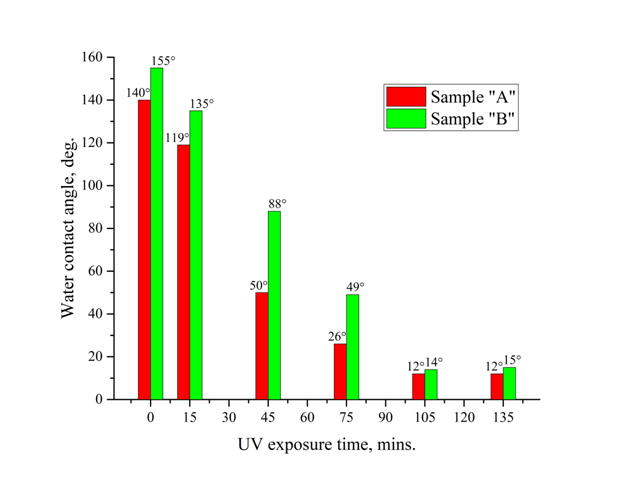Determination of the resistance of water-repellent properties to ultraviolet radiation on self-hydrophobized surface textures of AISI 304 steel
DOI:
https://doi.org/10.15587/2706-5448.2023.277986Keywords:
water contact angle, surface tension, water repellent coatings, superhydrophobicity, femtosecond laser, AISI 304 steelAbstract
In this work, the object of the study were femtosecond laser textured steel samples. Using a femtosecond laser to texture the surface both in the direct-beam mode, which provides microtextures, and in the reflection mode, which leads to the formation of LIPSS-type nanostructures on the surface. Such hybrid complexes are optimal in terms of water repellency as they embody the principle of hierarchical textures. This approach is one of the promising ways to solve the problem of scaling the process of obtaining superhydrophobic metal surfaces. The aim of the work is to establish the stability of water-repellent properties of micro- nanotextures obtained on the surface of AISI 304 steel after spontaneous hydrophobization under the action of UV radiation. The study of the obtained textured surface by scanning electron microscopy to confirm the presence of nanotexture and by energy-dispersive X-ray spectroscopy to establish the elemental composition of the obtained microtexture were made in the work. The paper shows that the water repellency of AISI 304 steel surfaces textured at micro and nano levels by femtosecond laser after long exposure to the atmosphere increases to a superhydrophobic state with the value of contact angles up to 155°. It has been shown that such surfaces are sensitive to UV radiation. Depending on the type of structure, the loss of hydrophobicity under experimental conditions occurs in 15-45 minutes of exposure, and complete hydrophilization of the surface occurs after 100 minutes of irradiation. As a result, the obtained self-hydrophobic surfaces are not suitable for operation under the influence of sunlight. However, ultraviolet radiation can be used to pre-clean such surfaces from adsorbed organic contaminants.
References
- Webb, H. K., Crawford, R. J., Ivanova, E. P. (2014). Wettability of natural superhydrophobic surfaces. Advances in Colloid and Interface Science, 210, 58–64. doi: https://doi.org/10.1016/j.cis.2014.01.020
- Choi, W., Tuteja, A., Mabry, J. M., Cohen, R. E., McKinley, G. H. (2009). A modified Cassie–Baxter relationship to explain contact angle hysteresis and anisotropy on non-wetting textured surfaces. Journal of Colloid and Interface Science, 339 (1), 208–216. doi: https://doi.org/10.1016/j.jcis.2009.07.027
- Cheng, B. K., Naccarato, B., Kim, K. J., Kumar, A. (2016). Theoretical consideration of contact angle hysteresis using surface-energy-minimization methods. International Journal of Heat and Mass Transfer, 102, 154–161. doi: https://doi.org/10.1016/j.ijheatmasstransfer.2016.06.014
- Zhuang, Y. X., Hansen, O. (2009). Correlation of Effective Dispersive and Polar Surface Energies in Heterogeneous Self-Assembled Monolayer Coatings. Langmuir, 25 (10), 5437–5441. doi: https://doi.org/10.1021/la804318p
- Gomes, D. J. C., de Souza, N. C., Silva, J. R. (2013). Using a monocular optical microscope to assemble a wetting contact angle analyser. Measurement, 46 (9), 3623–3627. doi: https://doi.org/10.1016/j.measurement.2013.07.010
- Ruben, B., Elisa, M., Leandro, L., Victor, M., Gloria, G., Marina, S. et al. (2017). Oxygen plasma treatments of polydimethylsiloxane surfaces: effect of the atomic oxygen on capillary flow in the microchannels. Micro & Nano Letters, 12 (10), 754–757. doi: https://doi.org/10.1049/mnl.2017.0230
- Fan, H., Su, Y., Song, J., Wan, H., Hu, L., Zhang, Y. (2019). Design of «double layer» texture to obtain superhydrophobic and high wear-resistant PTFE coatings on the surface of Al2O3/Ni layered ceramics. Tribology International, 136, 455–461. doi: https://doi.org/10.1016/j.triboint.2019.04.004
- Kietzig, A.-M., Hatzikiriakos, S. G., Englezos, P. (2009). Patterned Superhydrophobic Metallic Surfaces. Langmuir, 25 (8), 4821–4827. doi: https://doi.org/10.1021/la8037582
- Yuan, G., Liu, Y., Ngo, C.-V., Guo, C. (2020). Rapid fabrication of anti-corrosion and self-healing superhydrophobic aluminum surfaces through environmentally friendly femtosecond laser processing. Optics Express, 28 (24), 35636. doi: https://doi.org/10.1364/oe.400804
- Fürbacher, R., Liedl, G., Otto, A. (2022). Fast transition from hydrophilic to superhydrophobic, icephobic properties of stainless steel samples after femtosecond laser processing and exposure to hydrocarbons. Procedia CIRP, 111, 643–647. doi: https://doi.org/10.1016/j.procir.2022.08.016
- San-Blas, A., Martinez-Calderon, M., Buencuerpo, J., Sanchez-Brea, L. M., del Hoyo, J., Gómez-Aranzadi, M. et al. (2020). Femtosecond laser fabrication of LIPSS-based waveplates on metallic surfaces. Applied Surface Science, 520, 146328. doi: https://doi.org/10.1016/j.apsusc.2020.146328
- Zhang, L., Lin, N., Zou, J., Lin, X., Liu, Z., Yuan, S. et al. (2020). Super-hydrophobicity and corrosion resistance of laser surface textured AISI 304 stainless steel decorated with Hexadecyltrimethoxysilane (HDTMS). Optics & Laser Technology, 127, 106146. doi: https://doi.org/10.1016/j.optlastec.2020.106146
- Wang, N., Xiong, D., Deng, Y., Shi, Y., Wang, K. (2015). Mechanically Robust Superhydrophobic Steel Surface with Anti-Icing, UV-Durability, and Corrosion Resistance Properties. ACS Applied Materials & Interfaces, 7 (11), 6260–6272. doi: https://doi.org/10.1021/acsami.5b00558
- Myronyuk, O., Baklan, D., Vasilyev, G. S., Rodin, A. M., Vanagas, E. (2022). Wetting Patterns of Liquid-Repellent Femtosecond Laser Textured Aluminum Surfaces. Coatings, 12 (12), 1852. doi: https://doi.org/10.3390/coatings12121852
- Estrada-Martínez, J., Reyes-Gasga, J., García-García, R., Vargas-Becerril, N., Zapata-Torres, M. G., Gallardo-Rivas, N. V. et al. (2017). Wettability modification of the AISI 304 and 316 stainless steel and glass surfaces by titanium oxide and titanium nitride coating. Surface and Coatings Technology, 330, 61–70. doi: https://doi.org/10.1016/j.surfcoat.2017.09.059

Downloads
Published
How to Cite
Issue
Section
License
Copyright (c) 2023 Denys Baklan

This work is licensed under a Creative Commons Attribution 4.0 International License.
The consolidation and conditions for the transfer of copyright (identification of authorship) is carried out in the License Agreement. In particular, the authors reserve the right to the authorship of their manuscript and transfer the first publication of this work to the journal under the terms of the Creative Commons CC BY license. At the same time, they have the right to conclude on their own additional agreements concerning the non-exclusive distribution of the work in the form in which it was published by this journal, but provided that the link to the first publication of the article in this journal is preserved.







